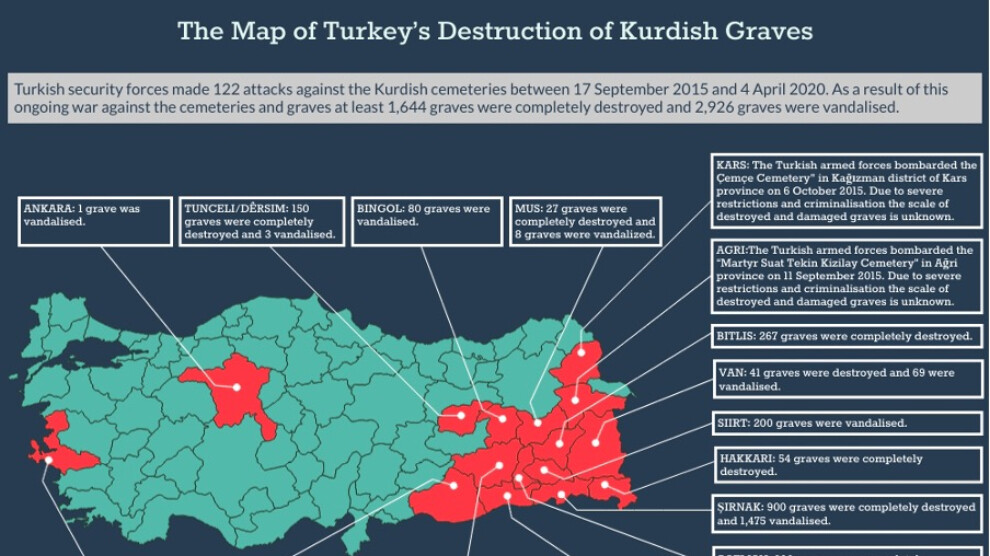Report on 'Turkey’s Destruction of Kurdish Graves’ published
Report reveals that Turkish security forces made 122 attacks against Kurdish cemeteries between 17 September 2015 and 4 April 2020.
Report reveals that Turkish security forces made 122 attacks against Kurdish cemeteries between 17 September 2015 and 4 April 2020.

Deniz Arbet Nejbir, a legal advisor at Mojust and an associate Fellow at the John Hopkins School of Advanced International Studies wrote a report titled ‘Turkey’s Destruction of Kurdish Graves’ and published by the Mesopotamia Observatory of Justice (MOJUST) and the Turkey based Özgürlük için Hukukçular Derneği (Association of Lawyers for Freedom – ÖHD). The report provides, for the first time, an unprecedented account of Turkey’s acts of destruction that have been directed against Kurdish cemeteries and graves in the South East of Turkey (North Kurdistan) from 2015 to the end of 2020.
The Turkish security forces’ systematic acts of destruction of Kurdish cemeteries and gravestones in 11 provinces of Southeast Turkey demonstrates one of the Justice and Development Party’s (AKP’s) modern suppression methods that has bolstered Turkey’s Kurdish annihilation policy. The Peoples’ Democracy Party (HDP), has made numerous attempts to hold the executive accountable in Parliament for these widespread and systematic attacks.
The significance of the report
This report is unique for three significant reasons. Firstly, it consolidates available news presented by domestic and international newspapers as well as news agencies and the findings of human rights associations in Turkey that have addressed the nature and form of the Turkish state’s attacks on Kurdish graves and cemeteries. Secondly, it demonstrates how the pro-Kurdish party, the Peoples’ Democracy Party (HDP), persistently tries to hold the executive accountable in Parliament for the widespread and systematic attacks that have taken place against Kurdish cemeteries and graves in North Kurdistan by the Turkish security forces.
Finally, it presents a rigorous study using empirical methods that have been used by both Mojust and ÖHD in their pro bono efforts to assist the victims of these attacks in their quest of justice in order to break the state’s traditional and systematic policy of impunity for perpetrators of these crimes. To provide a political context to these acts of destruction by the Turkish state, the first part of the report also provides a brief overview of Turkey’s Kurdish suppression policy under both the Kemalist (from 1923 to 2002) and the Erdoğan regimes (post-2002 to present).
The report has the added advantage of making publicly available information accessible, in one place, about Turkey’s systematic acts of destruction against Kurdish cemeteries and graves in North Kurdistan. In this context, this research fills an important gap in the field of Kurdish Studies.
The systematic nature of attacks against Kurdish cemeteries between 17 September 2015 and 4 April 2020
The findings of the report reveal that publicly accessible information indicates that Turkish security forces made 122 attacks against Kurdish cemeteries between 17 September 2015 and 4 April 2020. As a result of these ongoing acts of destruction of cemeteries and gravestones, at least 1,644 graves were completely destroyed and 2,926 graves were vandalised.
The Turkish security forces completely destroyed 18 cemeteries where the graves of fallen Kurdish Workers Party (PKK) militants are located in 11 provinces of Southeast Turkey (North Kurdistan) by air bombardments and using explosives during the above mentioned time periods.
In parallel with these attacks, the security forces have vandalized – in a systematic and widespread manner – the graves of PKK members in the public cemeteries in every province in the Kurdish region since 2015. Nine hundred graves, for example, were completely destroyed and 1,475 vandalised in Sirnak province; 143 graves were completely destroyed and 340 vandalised in Diyarbakir province; 200 graves were completely destroyed and 369 were vandalised in Batman province; 150 graves were completely destroyed and 3 vandalised in Tunceli (Dersim) province; 41 graves were destroyed and 69 were vandalised in Van province; 200 graves were vandalised in Siirt province; 232 graves were vandalised in Mardin province; 9 graves were completely destroyed and 3 graves were vandalised in Suruc/Sanliurfa; 267 graves were completely destroyed in Bitlis province; 54 graves were completely destroyed in Hakkari province; 27 graves were completely destroyed and 8 graves were vandalized in Mus province, whilst 80 graves were vandalised in Bingol province.
These figures also present the minimum number of graves which were destroyed and damaged. The exact numbers of graves targeted for destruction in the South-East are still unknown. As stated by the Unity and Culture Association for Aid and Solidarity with Families Who Lost Their Relatives in the Cradle of Civilizations (MEBYA-DER), the above figures of the vandalised graves provided in my research report can only “correspond to less than a quarter of the real figures” due to the fact that any research on his issue is constantly and persistently blocked and criminalized by the Turkish State.